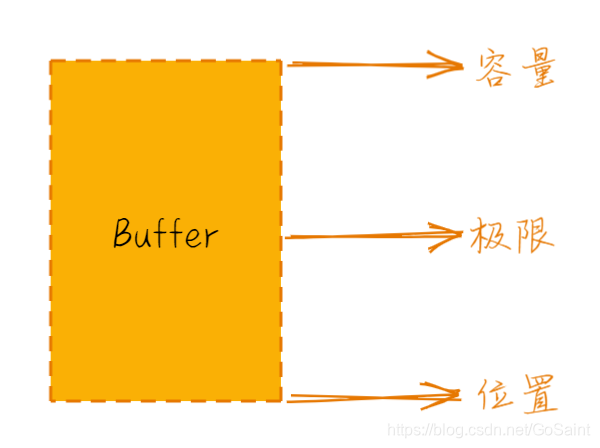一、前言
数据的输入和输出往往比较耗费性能。所以使用Buffer将数据存储起来。这样可以减少数据的读写次数。并且这块空间在创建的时候就会被分配内存空间,也会减少动态分配内存空间的次数

二、Buffer属性
1、buffer结构
capacity(容量): 表示缓冲区可以保存多少数据
limit(极限): 表示缓冲区的当前终点
position(位置): 表示缓冲区写一个读写单元的位置

2、buffer实例创建
ByteBuffer有静态方法allocate(int capacity)可以直接创建ByteBuffer实例。
ByteBuffer buffer = ByteBuffer.allocate(10);
创建的buffer的limit=capacity
关于分配内存。有两个方法,如下:
public static void main(String[] args) {
ByteBuffer buffer1 = ByteBuffer.allocate(10);
ByteBuffer buffer2 = ByteBuffer.allocateDirect(10);
System.out.println(buffer1.getClass());//class java.nio.HeapByteBuffer
System.out.println(buffer2.getClass());//class java.nio.DirectByteBuffer
}
HeapByteBuffer是堆内存上分配。相比DirectByteBuffer读写效率低下。因为DirectByteBuffer采用了零拷贝技术。并且HeapByteBuffer受到GC的影响。
DirectByteBuffer是直接内存分配。受制于系统,分配空间效率略微低下。
3、buffer 重要API

flip() :把极限设置为位置,把位置设置为0
clear(): 把极限设置为容量,把位置设置为0
compact():删除0到位置的数据,然后把位置到极限的数据复制到0到limit-position的位置。
三、读取文件示例代码
public static void main(String[] args) {
try (FileChannel channel = new FileInputStream("hello.txt").getChannel()){
//创建一个容量为10的buffer
ByteBuffer buffer = ByteBuffer.allocate(10);
while (true){
int read = channel.read(buffer);
if(read==-1){
break;
}
//每次读取完毕之后,将极限设置为位置,将位置设置为0。也就是接着上一次读取的地方读取
buffer.flip();
while (buffer.hasRemaining()){
byte b = buffer.get();
System.out.println((char) (b));
}
//将极限设置为容量,将位置设置为0.表示清空
buffer.clear();
}
} catch (IOException e) {
e.printStackTrace();
}
}
四、Buffer方法演示
演示工具类,需要添加Netty依赖。
package com.gosaint.bio.buffer;
import java.nio.ByteBuffer;
import io.netty.util.internal.MathUtil;
import io.netty.util.internal.StringUtil;
/**
* @author gosaint
* @date 2021/6/20 15:59
*/
public class ByteBufferUtil {
private static final char[] BYTE2CHAR = new char[256];
private static final char[] HEXDUMP_TABLE = new char[256 * 4];
private static final String[] HEXPADDING = new String[16];
private static final String[] HEXDUMP_ROWPREFIXES = new String[65536 >>> 4];
private static final String[] BYTE2HEX = new String[256];
private static final String[] BYTEPADDING = new String[16];
static {
final char[] DIGITS = "0123456789abcdef".toCharArray();
for (int i = 0; i < 256; i++) {
HEXDUMP_TABLE[i << 1] = DIGITS[i >>> 4 & 0x0F];
HEXDUMP_TABLE[(i << 1) + 1] = DIGITS[i & 0x0F];
}
int i;
// Generate the lookup table for hex dump paddings
for (i = 0; i < HEXPADDING.length; i++) {
int padding = HEXPADDING.length - i;
StringBuilder buf = new StringBuilder(padding * 3);
for (int j = 0; j < padding; j++) {
buf.append(" ");
}
HEXPADDING[i] = buf.toString();
}
// Generate the lookup table for the start-offset header in each row (up to 64KiB).
for (i = 0; i < HEXDUMP_ROWPREFIXES.length; i++) {
StringBuilder buf = new StringBuilder(12);
buf.append(StringUtil.NEWLINE);
buf.append(Long.toHexString(i << 4 & 0xFFFFFFFFL | 0x100000000L));
buf.setCharAt(buf.length() - 9, '|');
buf.append('|');
HEXDUMP_ROWPREFIXES[i] = buf.toString();
}
// Generate the lookup table for byte-to-hex-dump conversion
for (i = 0; i < BYTE2HEX.length; i++) {
BYTE2HEX[i] = ' ' + StringUtil.byteToHexStringPadded(i);
}
// Generate the lookup table for byte dump paddings
for (i = 0; i < BYTEPADDING.length; i++) {
int padding = BYTEPADDING.length - i;
StringBuilder buf = new StringBuilder(padding);
for (int j = 0; j < padding; j++) {
buf.append(' ');
}
BYTEPADDING[i] = buf.toString();
}
// Generate the lookup table for byte-to-char conversion
for (i = 0; i < BYTE2CHAR.length; i++) {
if (i <= 0x1f || i >= 0x7f) {
BYTE2CHAR[i] = '.';
} else {
BYTE2CHAR[i] = (char) i;
}
}
}
/**
* 打印所有内容
* @param buffer
*/
public static void debugAll(ByteBuffer buffer) {
int oldlimit = buffer.limit();
buffer.limit(buffer.capacity());
StringBuilder origin = new StringBuilder(256);
appendPrettyHexDump(origin, buffer, 0, buffer.capacity());
System.out.println("+--------+-------------------- all ------------------------+----------------+");
System.out.printf("position: [%d], limit: [%d]\n", buffer.position(), oldlimit);
System.out.println(origin);
buffer.limit(oldlimit);
}
/**
* 打印可读取内容
* @param buffer
*/
public static void debugRead(ByteBuffer buffer) {
StringBuilder builder = new StringBuilder(256);
appendPrettyHexDump(builder, buffer, buffer.position(), buffer.limit() - buffer.position());
System.out.println("+--------+-------------------- read -----------------------+----------------+");
System.out.printf("position: [%d], limit: [%d]\n", buffer.position(), buffer.limit());
System.out.println(builder);
}
private static void appendPrettyHexDump(StringBuilder dump, ByteBuffer buf, int offset, int length) {
if (MathUtil.isOutOfBounds(offset, length, buf.capacity())) {
throw new IndexOutOfBoundsException(
"expected: " + "0 <= offset(" + offset + ") <= offset + length(" + length
+ ") <= " + "buf.capacity(" + buf.capacity() + ')');
}
if (length == 0) {
return;
}
dump.append(
" +-------------------------------------------------+" +
StringUtil.NEWLINE + " | 0 1 2 3 4 5 6 7 8 9 a b c d e f |" +
StringUtil.NEWLINE + "+--------+-------------------------------------------------+----------------+");
final int startIndex = offset;
final int fullRows = length >>> 4;
final int remainder = length & 0xF;
// Dump the rows which have 16 bytes.
for (int row = 0; row < fullRows; row++) {
int rowStartIndex = (row << 4) + startIndex;
// Per-row prefix.
appendHexDumpRowPrefix(dump, row, rowStartIndex);
// Hex dump
int rowEndIndex = rowStartIndex + 16;
for (int j = rowStartIndex; j < rowEndIndex; j++) {
dump.append(BYTE2HEX[getUnsignedByte(buf, j)]);
}
dump.append(" |");
// ASCII dump
for (int j = rowStartIndex; j < rowEndIndex; j++) {
dump.append(BYTE2CHAR[getUnsignedByte(buf, j)]);
}
dump.append('|');
}
// Dump the last row which has less than 16 bytes.
if (remainder != 0) {
int rowStartIndex = (fullRows << 4) + startIndex;
appendHexDumpRowPrefix(dump, fullRows, rowStartIndex);
// Hex dump
int rowEndIndex = rowStartIndex + remainder;
for (int j = rowStartIndex; j < rowEndIndex; j++) {
dump.append(BYTE2HEX[getUnsignedByte(buf, j)]);
}
dump.append(HEXPADDING[remainder]);
dump.append(" |");
// Ascii dump
for (int j = rowStartIndex; j < rowEndIndex; j++) {
dump.append(BYTE2CHAR[getUnsignedByte(buf, j)]);
}
dump.append(BYTEPADDING[remainder]);
dump.append('|');
}
dump.append(StringUtil.NEWLINE +
"+--------+-------------------------------------------------+----------------+");
}
private static void appendHexDumpRowPrefix(StringBuilder dump, int row, int rowStartIndex) {
if (row < HEXDUMP_ROWPREFIXES.length) {
dump.append(HEXDUMP_ROWPREFIXES[row]);
} else {
dump.append(StringUtil.NEWLINE);
dump.append(Long.toHexString(rowStartIndex & 0xFFFFFFFFL | 0x100000000L));
dump.setCharAt(dump.length() - 9, '|');
dump.append('|');
}
}
public static short getUnsignedByte(ByteBuffer buffer, int index) {
return (short) (buffer.get(index) & 0xFF);
}
}
调用put方法写入buffer。写入了a、b、c、d
public static void main(String[] args) {
ByteBuffer buffer = ByteBuffer.allocate(10);
buffer.put((byte)0x61);
buffer.put((byte)0x62);
buffer.put((byte)0x63);
buffer.put((byte)0x64);
ByteBufferUtil.debugAll(buffer);
}

此时如果直接调用buffer.get()。那么会从当前的position开始读取,很明显读取不到数据。所以应该切换读取模式,调用flip()方法。将位置归0.

public static void main(String[] args) {
ByteBuffer buffer = ByteBuffer.allocate(10);
buffer.put((byte)0x61);
buffer.put((byte)0x62);
buffer.put((byte)0x63);
buffer.put((byte)0x64);
buffer.flip();
buffer.get();
ByteBufferUtil.debugAll(buffer);
buffer.compact();
ByteBufferUtil.debugAll(buffer);
}






















 823
823











 被折叠的 条评论
为什么被折叠?
被折叠的 条评论
为什么被折叠?








